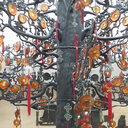Interplay of Efflux Transporters with Glucuronidation and Its Impact on Subcellular Aglycone and Glucuronide Disposition: A Case Study with Kaempferol.
Schlüsselwörter
Abstrakt
Glucuronidation is a major process of drug metabolism and elimination that generally governs drug efficacy and toxicity. Publications have demonstrated that efflux transporters control intracellular glucuronidation metabolism. However, it is still unclear whether and how efflux transporters interact with UDP-glucuronosyltransferases (UGTs) in subcellular organelles. In this study, kaempferol, a model fluorescent flavonoid, was used to investigate the interplay of glucuronidation with transport at the subcellular level. Human recombinant UGTs and microsomes were utilized to characterize the in vitro glucuronidation kinetics of kaempferol. The inhibition of UGTs and efflux transporters on the subcellular disposition of kaempferol were determined visually and quantitatively in Caco-2/TC7 cells. The knockout of transporters on the subcellular accumulation of kaempferol in liver and intestine were evaluated visually. ROS and Nrf2 were assayed to evaluate the pharmacological activities of kaempferol. The results showed that UGT1A9 is the primary enzyme responsible for kaempferol glucuronidation. Visual and quantitative data showed that the UGT1A9 inhibitor carvacrol caused a significant rise in subcellular aglycone and reduction in subcellular glucuronides of kaempferol. The inhibition and knockout of transporters, such as P-glycoprotein (P-gp), breast cancer resistance protein (BCRP), and multidrug resistance-associated proteins (MRPs), exhibited a marked increase in subcellular kaempferol and decrease in its subcellular glucuronides. Correspondingly, inhibition of UGT1A9 and transporters led to increased kaempferol and, consequently, a significantly enhanced ROS scavenging efficiency and nuclear translocation of Nrf2. In conclusion, the interplay of efflux transporters (P-gp, BCRP, and MRPs) and UGTs govern the subcellular exposure and corresponding pharmacological activity of kaempferol.





